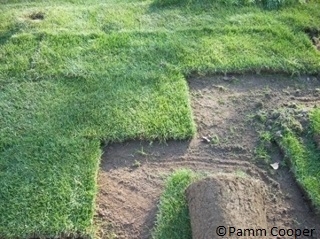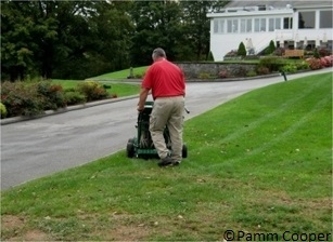Lawn Renovation and Repair
Late summer is an ideal time to renovate a lawn in poor condition in New England. Usually the shorter days bring slightly cooler weather where grass seed can germinate quickly but weed competition is less severe. There is still time for the grass seedlings to put down an adequate root system before the ground freezes and to store up carbohydrates for the next spring. Late summer and early fall rains help keep the seed moist for germination and help new plants take up the nutrients they need for proper establishment.
Before considering lawn renovation, it is a good idea to have the soil tested. If there are soil problems that need to be corrected, it is best to address these either before or during the renovation process. If existing soils are the reason for chronic turf problems, seeding or sodding alone will not be successful in the long run.
If shade is a factor in limiting the quality of the lawn, then trees or shrubs may have to be pruned or removed in order to provide a minimum of four hours of direct sunlight required by shade tolerant fescues. If it is not possible to correct shade problems, a woodland garden or a shade tolerant landscape planting or groundcover may be the best alternative.
Small thin or bare spots can be seeded by hand. Rake out any dead material and put seed down. Seed can be mixed with some top soil and raked down to the soil level in thin or bare areas. If weeds are pulled out during the growing season, put some grass seed down where the weeds were to help grass get a head start on future weeds.
A lawn having at least a 60% stand of acceptable turf can be renovated by using a slice- seeder. This is a machine that will drop seed directly into the soil as it makes shallow grooves with small discs. It is best to run the machine in two directions at a 45° angle to each other using a half-rate of seed for each pass. A starter fertilizer can be applied when over-seeding, or use a slow-release nitrogen fertilizer. Keep the seed moist in order to ensure germination.
If a lawn is severely compacted, it should be aerified first, and then slice-seeded. If a decent amount of turf is present, grass seed can be applied before the aerification holes completely heal up. Compost can be worked into the holes if the soil has a low percentage of organic matter, and limestone can be added as well if the soil is too acidic. If the turf stand is thin, a slice-seeder can be used after aerifying. Again, only a half-rate of seed may be necessary, depending upon how much of the lawn is still in decent shape.
Complete Renovation
If a lawn seems to be hopelessly beyond repair, complete renovation may be necessary. Usually the lawn is sprayed with an herbicide to kill any existing vegetation and then roto-tilled. Soil amendments can be worked in, such as limestone, compost, or even new topsoil, with the roto-tiller. Remove any debris such as rocks or roots and smooth the area to make sure there are no depressions. Roll or tamp down the soil and then seed in two directions. A starter fertilizer can be applied at this time, and seed and fertilizer can be worked lightly into the soil by dragging a metal leaf rake upside down over the surface. Roll or tamp lightly and then mulch, if possible. Keep the seed watered until it germinates and don’t let the seedlings wilt. Mow after the grass is 3 ½ inches high using sharp blades and be careful not to turn the mower on the new grass as roots are not deep yet and seedlings may be pulled from the ground when turns are sharp.
Sod can be used instead of seed, and will usually take about three weeks to be ready to mow. Most available sod is Kentucky bluegrass, and will need regular fertilizing and watering to maintain an acceptable turf stand that will resist weed invasion and drought conditions. New sod also must be watered regularly until the roots have been re-established. This is a more expensive enterprise, but the results are immediate. Be sure to make seams tight to prevent sod from drying out on the edges and to keep weeds from coming in. For smaller areas, existing vegetation can be removed with a sod-cutter and new sod can be laid down. Add some soil first if the depth where vegetation was removed will not allow an even transition with the new sod and the existing turf.
When to Renovate
August 15 through mid-September is the best time to establish or renovate a lawn in Connecticut. The latest date for seeding has always been before October 4. Once the soil begins to cool below 50°F, germination of the grass seed and growth of new seedlings slows down as frosts cool the soil well into late morning, if organic fertilizers are used, breakdown of nutrients slows as well. Weed competition tends to be lower later in the growing season as well.
If it is necessary to renovate a lawn in the spring, wait until conditions are favorable to germinate the seed. Soil temperatures should be above 50°F to ensure adequate germination in a timely fashion. Since weed competition, especially from summer annuals and crabgrass, may be a factor, consider using a pre-emergent herbicide at the time of planting that will allow the desirable grass seed to germinate but will prevent weed seeds from developing into plants. Two products safe to use as pre-emergent herbicides when seeding lawn grasses are Tupersan™ and Tenacity™. These are available for residential use in Connecticut and can be purchased by homeowners. Be sure to use according to instructions on the product label.
Mulching large seeded areas helps keep seed from drying out and may prevent erosion if heavy rains follow seeding. If straw is used do not use a heavy layer as this may promote seedling blight or may suffocate seedlings. Make sure some soil is visible through the straw. Hay should not be used as a mulch as it contains undesirable seeds. There are products available for mulching grass seed that are made up of ground recycled newspapers or wood pulp. These break down faster than straw and may be incorporated with a starter fertilizer.
Kentucky Bluegrasses and Perennial ryegrasses both require fertile, well- drained soils with a pH between 6.0–7.0. They do best when fertilized according to optimum growth requirements and when supplemental irrigation is applied during the summer. Consider using a fine-leaved fescue blend or turf-type tall fescue blend if supplemental irrigation is not possible or desired, for shady situations or if soil pH is too acidic for Bluegrasses or ryegrass. If soils are poor and irrigation is definitely out of the question, a blend of fine-leaved fescues may be best. For low maintenance areas, fine leaved fescues are the best choice.
If turf was lost due to disease or surface- feeding insect activity, consider using either grass cultivars resistant to the disease that caused the problem, or endophytic cultivars that will help the grass resist insect damage. If road salts cause turf loss along streets and sidewalks, try using a fine-leaved fescue or a turf-type tall fescue in these areas. They are more resistant to salt damage than Kentucky bluegrass and perennial ryegrass.
If some areas are troublesome every year, it may be time to try planting something else. Properly selected native plants are often a more suitable substitute for grass, especially in our rocky, acidic Connecticut soils. When you have done everything right but still cannot grow a suitable stand of grass, perhaps it is time to abandon turf in favor of something else.

Proper way to lay sod, overlapping the rolls

Over-seeding thin area of turf
Revised by UConn Home and Garden Education Center 2016.
Issued in furtherance of Cooperative Extension work, Acts of May 8 and June 30, 1914, in cooperation with the U.S. Department of Agriculture, the Dean of the College, Cooperative Extension System, University of Connecticut, Storrs. The Connecticut Cooperative Extension System is an equal opportunity employer and program provider. To file a complaint of discrimination, write USDA, Director, Office of Civil Rights, Room 326-W, Whitten Building, Stop Code 9410, 1400 Independence Avenue, SW, Washington, DC 20250-9410 or call (202) 720-5964.